Lock Nuts |
Lock nuts or locking nuts are special types of fasteners designed to provide secure fastening. Some suppliers call them self-locking nuts or stiffnuts. They are screwed onto a bolt or threaded rod just like standard nuts, but a lock nut then resists loosening under pressure or vibration forces.
Lock nuts were invented in the 1930s to reduce the cost of using nuts and lock washers in various types of machine assemblies. Before this, the best way to prevent nuts from loosening due to vibration was to use two standard nuts on one bolt. However, this doubled the cost of nuts and washers for each bolt in the assembly.
Because making or buying individual nuts costs very little, doubling in this way is still a relatively inexpensive solution at low production volumes. On a larger scale, however, it becomes exponentially more expensive, and so the self-locking nut was conceived as a more economical way to get around the problem of unwanted loosening.
Although lock nuts are individually more expensive than non-lock nuts, they are still a cheaper solution than buying and using two standard nuts. Today, lock nuts are used on all kinds of threaded rods and threaded ends in numerous industries and applications.
How do lock nuts work?
The main difference is that lock nuts are made and machined so that they do not easily loosen (work themselves loose) once they are screwed on.
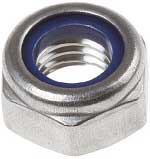
This makes lock nuts especially useful in applications where the bolt or nut is subject to vibration or torsional forces during installation. An obvious example of this can be found in engines and other automotive parts. They are also widely used in various other mechanical and industrial applications.
Most lock nuts work in two ways. Some are made to provide more friction once tightened, often via threaded designs with pits or grooves with flanges.
For example, some metal lock nuts have a small metal lip or crown that can be crimped inward after assembly. This physically holds the nut to the bolt shaft and prevents it from loosening due to vibration. Each of these two main categories of lock nuts has several subtypes.
Types of lock nuts
There are many different types of lock nuts, which fall broadly into two main categories; namely, prevailing torque nuts and surface bearing lock nuts.
Prevailing torque nuts are based on the principle of prevailing torque to prevent loosening due to vibration. In this context, the prevailing torque is the amount of force required to move the nut across the threaded shaft of a bolt or threaded rod so that the nut is firmly seated and does not loosen easily.
Specific examples of lock nuts with a prevailing torque are conical lock nuts, tri-lock nuts, top lock, Stover lock nut and Griptite lock nuts. Most are all-metal locknuts and many have some sort of lip or crown designed to be crimped around a bolt shaft after installation. This crimping process provides enough prevailing torque to hold the locknut in place, even under severe vibration.
However, not all metal nuts have a crimp section. Some are designed to create a prevailing torque through other mechanisms, such as tapered flange lock nuts. Many of these types of nuts must be turned in both directions, whether installed or removed.
Lock nuts for surface bearings rotates freely under normal conditions, but can be tightened against a bearing surface to activate a locking mechanism that holds the nut firmly in place.
Commonly purchased examples of types of locking nuts in common use are..
- Nylon insert lock nuts - with an inner bushing that molds to the thread pattern
- Hex nuts - basically a double nut system, where two pieces are tightened against each other
- Prevailing torque or Stover lock nuts
- Center lock nuts (also called two-sided lock nuts) - a common subtype of deformed threaded nuts, where the thread of the nut is intentionally designed to interfere with and eventually bind to the thread of the bolt
- Knurled flange lock nuts - another subtype of lock nuts with deformed threads
- Upper lock nuts
- Jet nuts or K-nuts
- Castellated or castle-lock nuts
Which locking nut is best for you depends on the specifics of the task you need to perform. Important things to consider include..
- Thread direction - lock nuts can be purchased with clockwise (right-handed) or counterclockwise (left-handed) threads
- The size of the lock nuts you need, in metric or imperial standards
- The type of assembly for which they will be used and the environment to which a lock nut will be exposed during its service life
- Whether the nut you choose needs secondary parts, such as a specific washer, to properly lock in place
- The material of which your lock nut is made
There are several subsets of the main types available, as well as a few more specialized models for very specific applications. Some of the more popular varieties are described below.
Knurled nuts have a serrated pattern around the outer edge for better finger grip. Along with thumb nuts and push-in nuts, a knurled nut is a type of lock nut designed to be tightened and loosened manually. In other words, it is a type of hand nut, as opposed to a nut designed to be turned in place with a wrench. However, some models are available with slots for screwdrivers in the head.
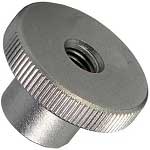
A wedge lock nut combines the nut itself with a wedge lock washer, which features a cam with a rise that is greater than the thread pitch of the bolt. They often come pre-assembled, meaning they are one piece. They can be used repeatedly on bolted joints and are suitable for demanding applications (including heavy loads and vibration).
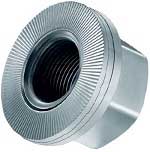
Nylon insert lock nuts are a popular and widely used type of lock nut because they are inexpensive to buy and effective in a wide range of environments. They have an inner sleeve of nylon plastic, which is designed to deform around the thread of the bolt and create binding friction.

An Aerotight nut is a brand name used to designate an all-metal (stainless steel) rigid nut, also called bent bar nuts. They have a built-in self-locking mechanism, which means they can be used and reused many times. They require no additional parts and are designed to stay in place regardless of whether they are fully tightened.
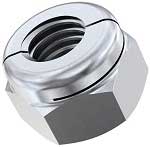
How to use lock nuts
The answer to how to lock nuts on bolts varies a bit depending on the type of lock nut you use. In most cases, however, initially tightening with your fingers works just like a standard hex nut. In many cases, you then have to continue tightening the locknut with a wrench or similar tool until you get the desired grip.
For some types, it is easy to decide which end of a locknut goes on first, because certain designs based on friction or torque dictate that a nut locks properly only when tightened in one direction. However, you must be careful whether you use a locknut with clockwise or counterclockwise threads.
Other designs and brands of lock nuts may require the use of a lock washer in addition to the nut itself to get full lock.
Lock nuts are available in a variety of styles, grades and finishes and are available according to ASTM, ISO and other standards. They can be manufactured with a standard hex or a heavy hex pattern.
Related Post(s)
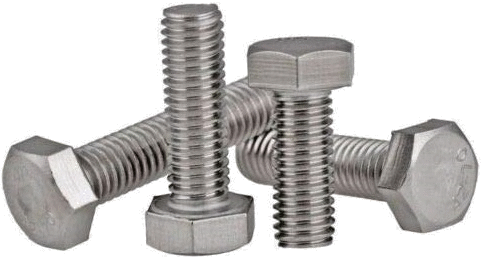
The two standards are exact the same with the exception of M10, M12, M14 and M22...